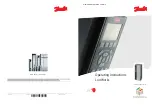
GUIDE TO INSTALLATION AND OPERATION
XVP-3901 |
47
Source:
Selects the source of AFD information – options are AFD (SMPTE 2016), VLI or WSS (for 625 sources only).
Insertion Line:
The Insertion line is used to select on which line in the VANC the AFD packet (SMPTE 2016) will be
inserted. It is not necessary to specify the detection line since the card will automatically detect the incoming packet.
Insertion:
The Insertion pull-down menu is used to enable or disable the insertion of AFD on the SD outputs:
•
For SD outputs, a selection must be made when enabling insertion:
o
525 outputs – AFD (SMPTE 2016) or VLI
o
625 outputs – AFD (SMPTE 2016), VLI or WSS
Flags
section
The Flags sub-section indicates which AFD flag is detected at the input and which flag is inserted at the output.
The Active Format Descriptor (AFD) flag is used to identify the aspect ratio and protected areas of a video signal. The
XVP-3901 uses this flag in some cases to adjust the output aspect ratio and image cropping to obtain the best
possible presentation of the image. The AFD flag is implemented differently in SD and HD:
•
In HD, the AFD flag (SMPTE 2016) is sent in an ancillary packet, normally found on line 11 in the vertical ancillary
space.
•
In SD, the AFD flag is sent as a VLI signal (RP 186) for 525 and 625 formats, as a WSS signal (ITU-R BT.1119-2)
for PAL only, and as an AFD packet (SMPTE 2016).
When AFD is present at the input, the card can perform an automatic adjustment of the aspect ratio. See the
appendix for more details.
Alternate ARC
section
When the output is 4:3 SD, if the input AFD setting is set to Auto or Forced mode and the input AFD is a full screen
16:9 (AFD code 16:9_8), the output image may be scaled in one of 2 ways. Use the pulldown to select which will be
used:
•
Letterbox:
Uses the traditional 16:9 letter box within a 4:3 frame where there is no loss of image.
•
Center Cut:
The XVP-3901 provides a second alternative – the input is horizontally cropped about the center to
create a full screen 4:3 image. Choosing this alternative essentially removes 25% of the original image.
5.5.6 De-interlacer
tab
Some interlaced video sources are film-based originating from 24p film images. For optimum scaling performance, it
would be best to de-interlace this type of source by simply merging the source’s fields to recreate the original 24p
image, thereby introducing no de-interlacer artifacts prior to scaling and format conversion.
Film mode:
When The Film Mode selection is set to ON, the
XVP-3901 monitors the input for film-based sequences and
applies the proper algorithm.
Film detection is provided for 3:2, 2:2 (59Hz and 50 Hz
sources) and 5:5 sequences.
Video Over Film:
When the film mode is enabled, turn ON
the Video-Over-Film (VOF) function to detect and bypass
field-merging on certain video regions such as scrolling video characters over an entire film frame, thereby preventing
any unwanted combing effects.
There is only one de-interlacer on the card. Any changes made within this tab will be copied over to the De-interlacer
tab in the Video Output – 3G/HD panel.
Figure 5.33
Video Outputs SD - De-interlacer tab
















































